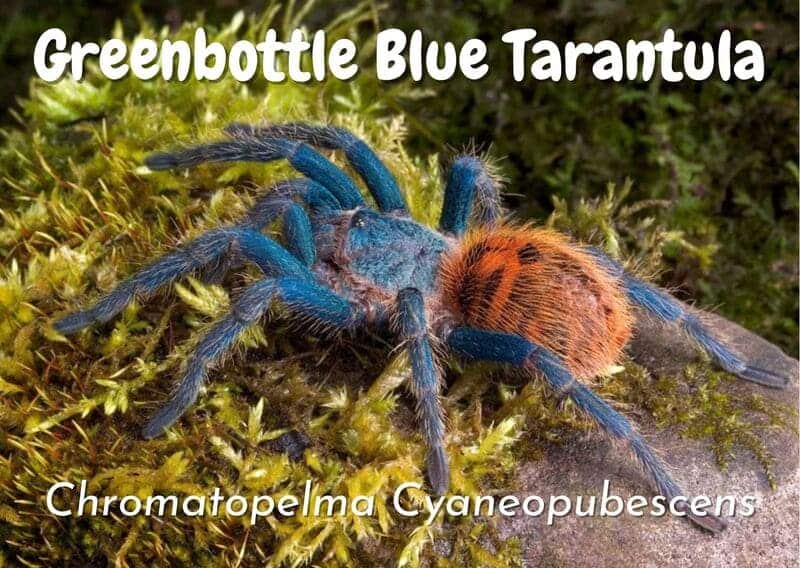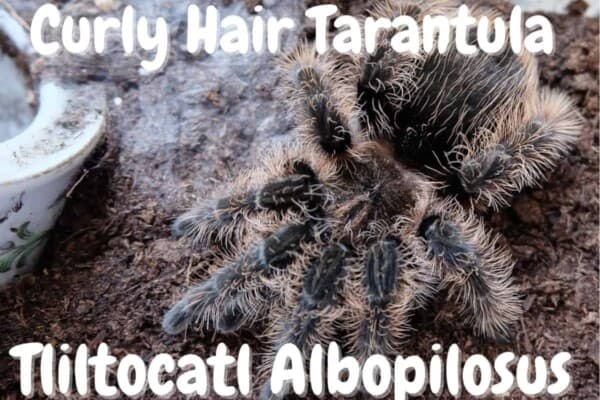The Greenbottle Blue tarantula is amazingly vivid looking with colors that stand out in any collection. They are Venezuelan desert spiders that make an incredible web that will cover much of their enclosure. If you have some experience with tarantulas, the Greenbottle Blue might be for you.
Species name
Chromatopelma Cyaneopubescens- Described by Embrik Strand (1907) as Eurypelma cyaneopubescens. It was later renamed to its current name by Schmidt in 1995.
Characteristics
This species is considered a New World terrestrial spider originating from desert climates in Northern Venezuela, Paraguana. This bird spider features incredible colors both as slings and mature adults.
They are uniquely colored with emerald green iridescent carapace colors and shimmering metallic blue legs. The abdomen is black with orange hairs growing all over. Often the abdomen keeps the ornamental designs and is seen through the orange highlighting hairs.
The slings have detailed gold-colored ornamental carapaces with bright orangey-peach legs and black upper legs at their connecting point. Their abdomens are black with pumpkin orange stripes and ornamental designs. The slings also stand out with their blackleg tips.
Size
Females are much larger than males in overall length. A mature female can reach 6 inches (15.24cm) while the male is 4 inches (11.43cm). They will have a 3-inch leg span, however, the males will have skinnier legs. Females will look chunkier too.
Temperament
This species is known to be docile but they can be very skittish and nervous upon approaching. Their reaction is to run from the danger which can be harmful to them if you are handling them. One other defense is to flick their urticating hairs on you. They are not prone to biting, yet they can if they are scared.
Lifespan
Females will live in captivity for up to 12-14 years, while males will only live for 3-4 years in all. Males can mature after one year (roughly 14 months) Females mature at 1.5-2 years.
Difficulty of Care
This Greenbottle Blue tarantula is for expert beginners who already know how to take care of a tarantula. It’s not exactly a first-timer spider by all means. Since it’s a desert spider it cannot be treated like other terrestrial spiders that burrow. This spider can be likened to arboreal in some ways.
Housing the Green Bottle Blue Tarantula
The important thing to remember is that the Greenbottle Blue tarantula needs plenty of room in their tank to move around. They need 3 times the amount of space as other mature species. Commonly, some owners will choose a 5-10 gallon tank. It needs to have a secure top that’s escape-proof.
If the tank has a front closure, it will make it easier when it comes time for feeding. You can have better luck with cleaning a glass container since silk webbing can stick more to plastic.
Cleaning
Your Green Bottle Blue will be a heavy webber, and for obvious reasons, you will need to clean the enclosure at least once a month. This is to remove trapped dead bolus and insects that just happen to get snared in these funnel-shaped webs. If you are a newbie at web cleaning, this species will be more intensive for cleaning off all the silk.
Accessories
You can select from a variety of rocks, bark, various hides, and a shallow water dish. The rest is your choice of desert-themed decorations of your choice. If you add plastic or real plants, they will be covered with the web and can be harder to clean. They do like to climb small shrubs and tree bark.
Humidity and temperature
This species is much more tolerant of harsh climates than other terrestrial spiders that live in sub-tropical jungles. You can keep the humidity at 60% since they came from a desert-like climate with low shrubs and sand. Be sure to add a hygrometer to keep track of the humidity inside the tank. Previous owners more than 20 years ago didn’t understand why their Greenbottle Blue tarantula was getting sick in their tank – it was because the humidity was too high.
The overall temperature can range between 78-82F. Some owners have noted that an ideal temperature can be as low as 70- 72F. Depending on where you live it should not go over or under the temperatures of 70-82F. Have an accurate thermometer that is attached to your tank.
Lighting
Lighting for your greenbottle blue is simple enough with an adjustable lamp next to the enclosure. It’s not just for aesthetic reasons, especially for this desert-dwelling species. They need to bask in the light for at least 12 hours a day. If it’s too much they’ll retreat to their hide. Use an incandescent 30-watt bulb to keep the temperature constant during the day.
Substrate
The substrate can be a mixture of soil, coarse to medium sand, and peat or sphagnum moss. These can be equal amounts or one-third parts of each. This substrate needs to be 2 inches thick over the bottom of the tank. The Greenbottle Blue does not burrow and makes a hide from its webbing. The soil does not need to be moist, it will rarely need spraying, but it does need water from time to time.
How to feed the Greenbottle Blue tarantula
Adults will have a diet of crickets, small scorpions, beetles, and worms. Spiderlings will need to eat nymph crickets and mealworms or wax worms.
How often
Mature spiders can eat every 7-10 days on average. Little spiderlings will need to eat more often between 4-7 days overall. It seems that spiderlings will take on prey their size and are always hungry. Despite the recommended size of their carapace, the little ones are feisty feeders. Anytime a spider has molted, you must not feed them for a while. Spiderlings take 1-2 days to recover from the molt, while adults can take two or more weeks.
Drink
Provide a water dish that is no more than 3 inches in diameter. It should be shallow and set into the substrate just at the same level. It needs to be cleaned and filled every day. Water is essential to the Greenbottle blue tarantula and without freshwater they can become dehydrated.
Handling the Chromatopelma Cyaneopubescens
Handling is not recommended if you are not experienced with this species. It is docile enough as a terrestrial spider but is prone to being skittish. The bite is not deadly and any kind of handling should be done with care. Some people can be allergic to spider bites just like honey-bee stings, so take caution if you are allergic. Spiderlings are fearless and have very little fear of being spooked, they are prone to bolting away quickly.
Common health problems
This species is not known to have many health issues however its climate needs to be dry enough to meet its needs. Too much humidity will make them sick.
When it comes to mites or parasites they can be at risk if there is an outbreak. Be sure to always clean the substrate once a month. Soil and moss must be baked at 150F for one hour to ensure that any living bacteria or mites are dead before putting them inside the habitat.
Breeding the Greenbottle Blue Tarantula
Males can mature after 14 months and will molt. When their molting is complete they need an additional 4-6 weeks before they are ready to collect their sperm sack for mating.
Females mature at 1.5-2 years but will also need to molt before she is ready to encounter a male. Spring needs to be simulated in the tank with one side being sprayed daily for one week.
Your female must be fed well at this time. Since this happens once a year only, you can introduce a ready male into the tank. Provide places for the male to run if he is successful. Often the male doesn’t get lucky and becomes a meal for the female.
After a mating, keep feeding her until she stops eating. Let the habitat dry out and she will retreat to her hide to make the cocoon. This can take up to 3-4 months after the mating has happened.
How many eggs does a female Greenbottle Blue tarantula lay?
The female can lay up to 100 eggs that will hatch on their own. They will be a hungry mob and likely start to eat the remaining unhatched eggs. Depending on how many eggs are laid you can remove them from where they are stored after 4 weeks.
What to do with spiderlings
If you decide to separate the eggs from the mother they need to be placed in an incubator. This will keep the temperature at a constant 65-70% humidity and 77-82.4F. After hatching they will need to be separated and stored in dipping sauce containers with lids. Don’t forget to poke holes in the lids for air. You can raise them or sell them to other spider collectors.
Availability
This is not a hard species to find and purchase. The Greenbottle Blue Tarantula is admired for its color and will make a great show spider in your collection. The average price for a Greenbottle blue tarantula is between $60 and $80 USD, so make sure to shop around to find a good deal.













